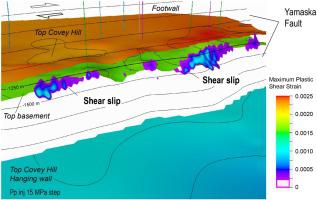International Journal of Greenhouse Gas Control ( IF 4.6 ) Pub Date : 2020-09-30 , DOI: 10.1016/j.ijggc.2020.103159 Elena Konstantinovskaya , Qiuguo Li , Michel Malo , Jose A. Rivero , Majid M. Faskhoodi , Bradley Campbell

|
How would high-angle normal faults be reactivated under a present-day strike-slip tectonic regime if reservoir pore pressure (Pp) increased during injection operations? What parameters would control shear slip localization? To answer these questions, 3D one-way coupled reservoir geomechanical modeling of potential fault reactivation in the St. Lawrence Platform, Quebec is performed. We evaluate the risk of shear failure along the pre-existing subsurface Yamaska high-angle normal fault under the present-day strike-slip tectonic regime. Slip may be generated by pressure perturbations in deep saline aquifers of the Early Paleozoic sedimentary basin; this has implications for the assessment of risks associated with CO2 storage and deep geothermal energy potential. The Yamaska Fault is oriented NE-SW with a strike varying from subparallel to ∼35° to the orientation of maximum horizontal stress (NE63°) and dips to the SE at ∼60° with ∼800 m of vertical throw. Multiple runs of the 3D model simulate steps of increasing Pp by 4, 6, 8 and 15 MPa in the footwall sandstone reservoir at a depth of 1.25-1.5 km. Our modeling results show plastic shear deformation along the Yamaska Fault is initiated by pressure increase of 4-6 MPa. More model fault cells fail when pore pressure is increased by 8 MPa, when the reservoir pressure reaches ∼21-24 MPa, and a larger area slips during the next injection stage. The non-linear geometry of the fault results in localization of plastic shear strain on the fault segments optimally oriented, while other segments remain inactive. The dextral plastic shear deformation occurs mostly at the depth of the injection interval, propagating upward to the caprock in highly stressed fault segments. Our study helps to quantify the risk of fault reactivation induced by injection operations.
中文翻译:

油藏孔隙压力增加引起的高角度正断层走滑复活:3D耦合油藏地质力学建模的启示
如果在注入作业期间储层孔隙压力(Pp)增加,那么在当今的走滑构造条件下如何重新激活大角度正断层?哪些参数将控制剪切滑移局部化?为了回答这些问题,在魁北克的圣劳伦斯平台进行了潜在断层再激活的3D单向耦合油藏地质力学建模。我们评估了当今走滑构造条件下沿现有地下亚山斯卡大角度正断层的剪切破坏的风险。滑动可能是由早古生代沉积盆地深层盐水中的压力扰动产生的。这对与CO 2相关的风险评估有影响储量和深层地热能潜力。Yamaska断层的走向为NE-SW,走向从次平行到约35°到最大水平应力方向(NE63°)不等,并在约60 m处向SE倾斜,垂直投掷约800 m。3D模型的多次运行模拟了在1.25-1.5 km深度的底盘砂岩储层中将Pp增加4、6、8和15 MPa的步骤。我们的模拟结果表明,沿Yamaska断层的塑性剪切变形是由4-6 MPa的压力增加引起的。当孔隙压力增加8 MPa,储层压力达到约21-24 MPa时,更多的模型断层单元会失效,并且在下一个注入阶段会滑移更大的面积。断层的非线性几何形状导致塑性剪切应变在断层段上最佳定位,而其他段保持不活动状态。右旋塑性剪切变形主要发生在注入间隔的深度,在高应力断层段中向上传播至盖层。我们的研究有助于量化注入操作引起的故障重新激活的风险。











































 京公网安备 11010802027423号
京公网安备 11010802027423号